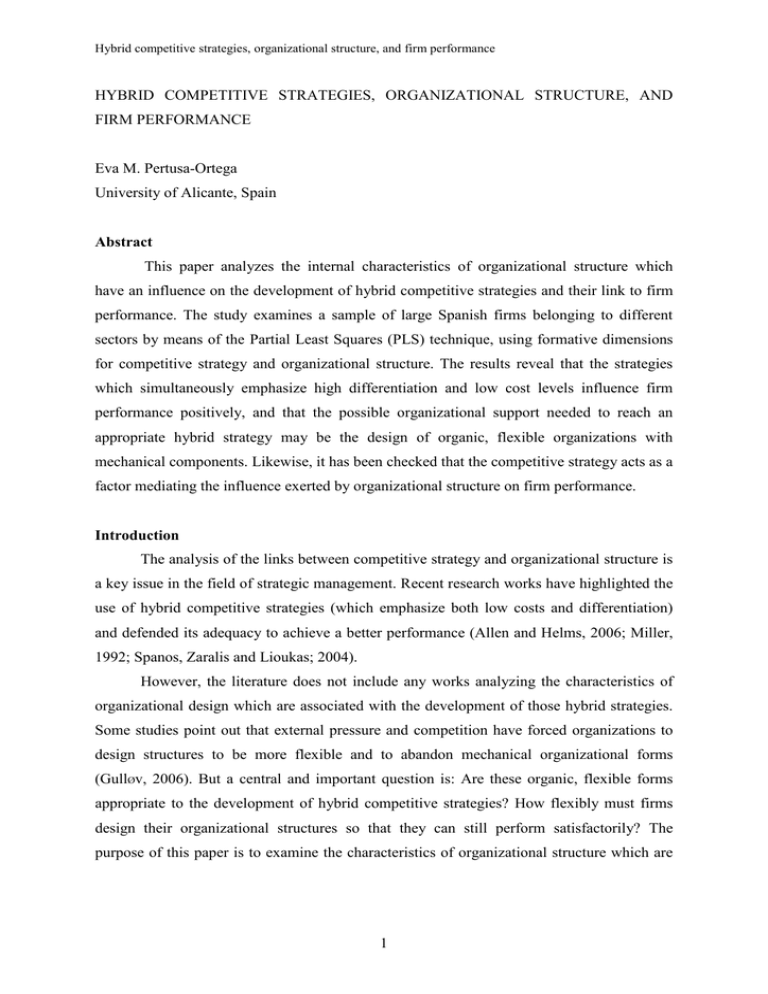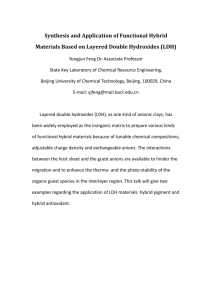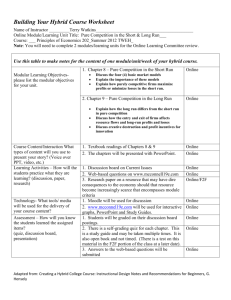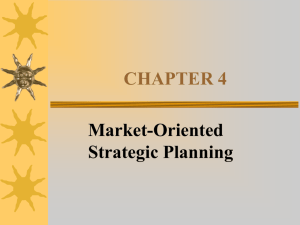HYBRID COMPETITIVE STRATEGIES, ORGANIZATIONAL STRUCTURE, ... FIRM PERFORMANCE Eva M. Pertusa-Ortega
advertisement

Hybrid competitive strategies, organizational structure, and firm performance HYBRID COMPETITIVE STRATEGIES, ORGANIZATIONAL STRUCTURE, AND FIRM PERFORMANCE Eva M. Pertusa-Ortega University of Alicante, Spain Abstract This paper analyzes the internal characteristics of organizational structure which have an influence on the development of hybrid competitive strategies and their link to firm performance. The study examines a sample of large Spanish firms belonging to different sectors by means of the Partial Least Squares (PLS) technique, using formative dimensions for competitive strategy and organizational structure. The results reveal that the strategies which simultaneously emphasize high differentiation and low cost levels influence firm performance positively, and that the possible organizational support needed to reach an appropriate hybrid strategy may be the design of organic, flexible organizations with mechanical components. Likewise, it has been checked that the competitive strategy acts as a factor mediating the influence exerted by organizational structure on firm performance. Introduction The analysis of the links between competitive strategy and organizational structure is a key issue in the field of strategic management. Recent research works have highlighted the use of hybrid competitive strategies (which emphasize both low costs and differentiation) and defended its adequacy to achieve a better performance (Allen and Helms, 2006; Miller, 1992; Spanos, Zaralis and Lioukas; 2004). However, the literature does not include any works analyzing the characteristics of organizational design which are associated with the development of those hybrid strategies. Some studies point out that external pressure and competition have forced organizations to design structures to be more flexible and to abandon mechanical organizational forms (GullØv, 2006). But a central and important question is: Are these organic, flexible forms appropriate to the development of hybrid competitive strategies? How flexibly must firms design their organizational structures so that they can still perform satisfactorily? The purpose of this paper is to examine the characteristics of organizational structure which are 1 Hybrid competitive strategies, organizational structure, and firm performance related to the development of hybrid competitive strategies, seeking to obtain higher performance levels. This study aims to make several contributions to the literature on strategic management. Firstly, previous research has often associated structure characteristics and the generic strategies described by Porter (1980) attending to their respective first-order dimensions (Miller, 1988; Pelham and Wilson, 1996). Instead, the model proposed in this paper uses second-order factors which seek to reflect better such abstract, multidimensional management constructs as structure and strategy. Secondly, this paper considers that the dimensions of organizational structure and competitive strategy are additive in nature (formative dimensions) rather than reflective (Podsakoff, Shen and Podsakoff, 2006), i.e. they can be estimated as the linear combination of all the dimensions, each one of them measuring different aspects. This is an important difference with respect to some studies which have used second-order reflective-type factors (Spanos and Lioukas, 2001). And thirdly, the present study tries to analyze and quantify both the direct and the indirect effects of structure and strategy on performance. Theory and Hypotheses Porter (1980, 1985) has often argued against the simultaneous pursuit of low cost and differentiation strategies (pure strategies) on the grounds that each one of them involves a different set of resources and organizational arrangements. Other authors have shown that low costs and differentiation may be compatible approaches to dealing with competitive forces, though (Allen and Helms, 2006; Miller, 1992; Spanos, Zaralis and Lioukas; 2004), and postulated the pursuit of what has been termed ‘hybrid’, ‘mixed’, ‘integrated’, or ‘combination’ strategies (Kim, Nam and Stimpert, 2004; Spanos, Zaralis and Lioukas, 2004). These ‘hybrid’ strategies are the ones which combine low cost and differentiation elements (Gopalakrishna and Subramanian, 2001; Proff, 2000). From a theoretical point of view, the arguments for the adoption of hybrid strategies stem from some problems associated with pure strategies (Miller, 1992). Thus, hybrid strategies may address customer needs better; they may be more difficult to imitate; and they may generate a more flexible, wider view. The pursuit of hybrid competitive strategies may help obtain several sources of advantage, and thus make it possible to achieve higher performance levels (Beal and Yasai-Ardekani, 2000). 2 Hybrid competitive strategies, organizational structure, and firm performance H1. A hybrid strategy with high levels of differentiation and low costs will have a positive influence on performance. Regarding the linkage between competitive strategy and organizational structure, low cost strategies have traditionally been associated with mechanical, rigid structures, whereas differentiation strategies are connected with organic, flexible structures (Miller, 1986, 1988; Govindarajan, 1988). Designing a hybrid strategy which emphasizes both differentiation and low costs is bound to require an organizational structure which combines flexibility and stability. Formalization has traditionally been associated with inertia, stability, efficiency, and cost reduction (Mintzberg, 1979). Rules providing specific behavioral directives for members to follow generate cost savings through the reduction of money wastes and time losses, but can equally encourage collaboration and cooperation between individuals to facilitate differentiation. Structural complexity can promote both low cost and differentiation strategies. High levels of complexity indicate diverse bases of expertise which may result in the identification of a wide range of problems (both in costs and in differentiation) and the availability of diverse kinds of information and perspectives about problem-solving (Aiken, Bacharach and French, 1980). Job specialization not only makes it possible to reduce costs by means of experience and learning economies but also may improve innovation differentiation or marketing differentiation thanks to the possibility to achieve improvements in the activities performed. Decentralization fosters the incorporation of a greater number of individuals and organizational levels into the strategic reflection process. When individuals are allowed to act autonomously (Nonaka, 1994), the organization can obtain better business opportunities in relation to new products or services, or cost reductions. Instead, centralization might increase costs due to the existence of time-consuming formal communication channels. H2. An organizational structure characterized by being flexible and stable at the same time will have a positive influence on the development of a hybrid strategy, with high levels of differentiation and low costs. 3 Hybrid competitive strategies, organizational structure, and firm performance In the resource-based view, organizational structure might be considered a resource, referred to as ‘organizational capital’ (Barney, 1991), or an organizational capability (Amit and Schoemaker, 1993). Therefore, organizational structure seems to appear as a fundamental element in the achievement and maintenance of a competitive advantage thanks to its function of organizing and coordinating all the resources available with the aim of meeting customer demands satisfactorily. Nevertheless, resources are not valuable in themselves (Porter, 1991); in fact, their value largely depends on the extent to which they can give support to the strategy pursued (Spanos and Lioukas, 2001). This argument seems to suggest that the influence exerted by organizational structure on performance is going to be indirect through the competitive strategy (Edelman, Brush and Manolova, 2005). H3. Organizational structure will not influence performance directly; it will do so indirectly through the competitive strategy. Methodology The study analyzes a sample of large Spanish firms belonging to different sectors using the Partial Least Squares (PLS) technique, which is now quite well established as a method to estimate path coefficients in causal models (Fornell and Bookstein, 1982; Hulland, 1999; Chin, Marcolin and Newsted, 2003), its main purpose being the prediction of empirical and/or theoretical variables. PLS offers a measure of the predictive value of a model, makes it possible to quantify the direct and indirect effects of some variables on others, as well as to observe the weight of each one of the dimensions shaping each construct (competitive strategy and organizational structure). PLS uses a least squares estimation procedure that provides the flexibility to represent both formative and reflective latent constructs. The formative specification is appropriate when the indicators directly help create the construct, while the reflective specification assumes that the indicators reveal various correlated features of an underlying construct (Podsakoff, Shen and Podsakoff, 2006). Results Figure 1 shows the PLS structural model. The analyses carried out confirm all three hypotheses. Firstly, the study indicates that strategies showing higher levels of performance are hybrid strategies which emphasize (a) innovation differentiation, (b) low costs; and (c) marketing differentiation. Secondly, the organizational structure which favours the 4 Hybrid competitive strategies, organizational structure, and firm performance development of a hybrid strategy of this kind is one that presents a lower degree of centralization and use of formalization, and a higher degree of organizational complexity and existence of rules and regulations. Therefore, the possible organizational support to reach an appropriate hybrid strategy may be the design of organic, flexible organizations with mechanical components. Thirdly, Figure 1 shows that organizational structure does not influence firm performance directly, but indirectly through the competitive strategy. Figure 1. Structural model results Low cost .485 Size Strategy R2= .169 Q2= -.099 Marketing Diff. .209 Innovation Diff. .711 .155* .459*** Performance R2= .378 Q2= .096 .411*** Centralization -.381 -.045 -.344*** Existence of formalization Structure .523 Use of formalization Complexity Industry -.284 .565 * p<.05; ** p<.01; ** p<.001 Conclusions This paper makes several contributions to the literature on strategy. First, it links the traditional contingency theory of organizational design to the resource-based view. Second, the analysis of the generic competitive strategies has been extended, providing empirical evidence that hybrid strategies are related to higher performance levels, regardless of the industrial sector firms belong to. And third, an analysis has been made about the organizational design dimensions which are associated with the development of hybrid competitive strategies. The research study offers interesting results for managers too, as it offers some of the strategic dimensions which may help to improve the organization’s performance if combined properly. Therefore, the first idea that can be transmitted to managers is that differentiation and cost strategies can be developed in a complementary way with a view to increase firm performance. Another important practical implication for managers is that they must be aware of the strategic value of their organizational structure, as the latter has a direct 5 Hybrid competitive strategies, organizational structure, and firm performance influence on the competitive strategy, and an indirect one on performance. Once this value has been recognized, managers will need to build an internally consistent organizational design that favors hybrid strategies, for which purpose, organic and flexible structures must incorporate mechanical elements into the design. References Aiken M, Bacharach S, French JL. 1980. Organizational structure, work process, and proposal making in administrative bureaucracies. Academy of Management Journal 23 (4): 631-652. Allen RS, Helms MM. 2006. Linking strategic practices and organizational performance to Porter’s generic strategies. Business Process Management 12 (4): 433-454. Amit R, Schoemaker, PJH. 1993. Strategic assets and organizational rent. Strategic Management Journal 14 (1): 33-46. Barney JB. 1991. Firm resources and sustained competitive advantage. Journal of Management 17 (1): 99-120. Beal RM, Yasai-Ardekani M. 2000. Performance implications of aligning CEO functional experiences with competitive strategies. Journal of Management 26 (4): 733-762. Chin WW, Marcolin BL, Newsted PR. 2003. A Partial Least Squares latent variable modeling approach for measuring interaction effects: results from a Monte Carlo simulation study and an electronic-mail emotion/adoption study. Information Systems Research 14 (2): 189-217. Edelman LF, Brush CG, Manolova T. 2005. Co-aligment in the resource-performance relationship: strategy as mediator. Journal of Business Venturing 20: 359-383. Fornell C, Bookstein FL. 1982. Two structural equation models: LISREL and PLS applied to consumer exit-voice theory. Journal of Marketing Research 19 (4): 440-452. Gopalakrishna P, Subramanian R. 2001. Revisiting the pure versus hybrid dilemma: Porter’s generic strategies in a developing economy. Journal of Global Marketing 15 (2): 6179. Govindarajan V. 1988. A contingency approach to strategy implementation at the businessunit level: integrating administrative mechanisms with strategy. Academy of Management Journal 31 (4): 828-853. 6 Hybrid competitive strategies, organizational structure, and firm performance GullØv T. 2006. Structural limitations in organizational design: the integrationdifferentiation paradigm. In Organization Design. The Evolving State-of-the-Art, Burton RM, Eriksen B, Håkonsson DD, Snow CC (eds). Springer: New York; 67-83. Hulland J. 1999. Use of Partial Least Squares (PLS) in strategic management research: a review of four recent studies. Strategic Management Journal 20 (2): 195-204. Kim E, Nam D, Stimpert JL. 2004. The applicability of Porter’s generic strategies in the digital age: assumptions, conjectures, and suggestions. Journal of Management 30 (5): 569-589. Miller D. 1986. Configurations of strategy and structure: towards a synthesis. Strategic Management Journal 7 (3): 233-249. Miller D. 1988. Relating Porter’s business strategies to environment and structure: analysis and performance implications. Academy of Management Journal 31 (2): 280-308. Miller D. 1992. The generic strategy trap. The Journal of Business Strategy 13 (1): 37-41. Mintzberg H. 1979. The Structuring of Organizations: A Synthesis of the Research. PrenticeHall: New Jersey. Nonaka I. 1994. A dynamic theory of organizational knowledge creation. Organization Science 5 (1): 14-37. Pelham AM, Wilson DT. 1996. A longitudinal study of the impact of market structure, firm structure, strategy, and market orientation culture on dimensions of small-firm performance. Journal of the Academy of Marketing Science 24 (1): 27-43. Podsakoff NP, Shen W, Podsakoff PM. 2006. The role of formative measurement models in strategic management research: review, critique, and implications for future research. Research Methodology in Strategy and Management 3: 197-252. Porter M. 1980. Competitive Strategy. Free Press: New York. Porter M. 1985. Competitive Advantage. Creating and Sustaining Superior Performance. Free Press: New York. Porter M. 1991. Towards a dynamic theory of strategy. Strategic Management Journal 12: 95-117. Proff H. 2000. Hybrid strategies as a strategic challenge. The case of the German automotive industry. Omega, The International Journal of Management Science. 28: 541-553. Spanos YE, Lioukas S. 2001. An examination into the causal logic of rent generation: contrasting Porter’s competitive strategy framework and the resource-based perspective. Strategic Management Journal 22 (10): 907-934. 7 Hybrid competitive strategies, organizational structure, and firm performance Spanos YE, Zaralis G, Lioukas S. 2004. Strategy and industry effects on profitability: evidence from Greece. Strategic Management Journal 25 (2): 139-165. 8







